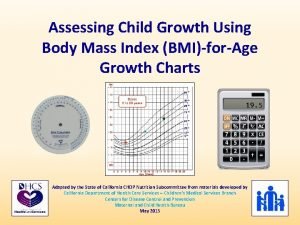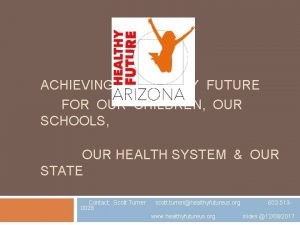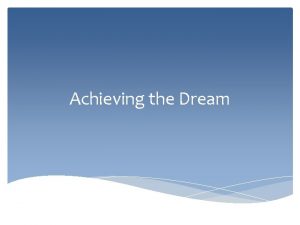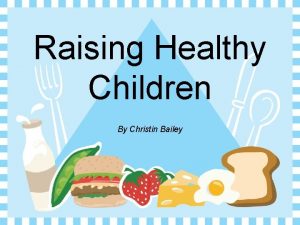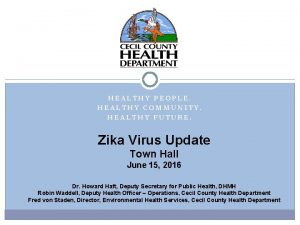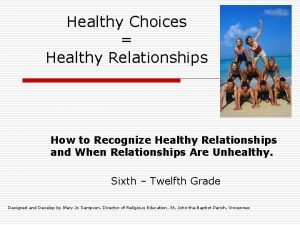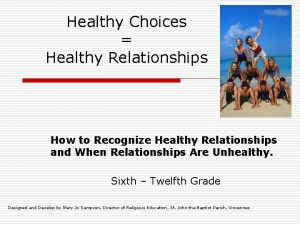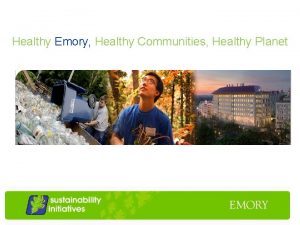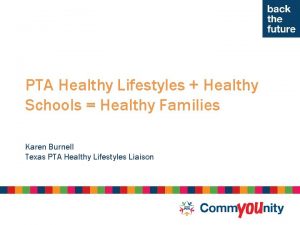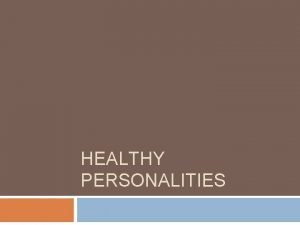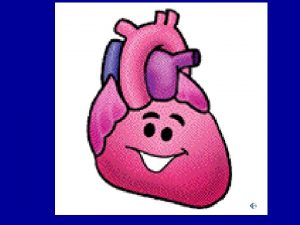ACHIEVING A HEALTHY FUTURE FOR OUR CHILDREN OUR








































- Slides: 40

ACHIEVING A HEALTHY FUTURE FOR OUR CHILDREN, OUR SCHOOLS, OUR HEALTH SYSTEM & OUR STATE Contact: Scott Turner scott. turner@edunuity. org 602513 -0028 10/03/2017

A Win-Win Agenda 2 Prevent 1/3 Children Diabetic Adults With Proven Programs & Policies K-12 Investing Health $$ Savings into Schools Notes: Google images: OTC Wholesale. School Book. Slide

AZ Stakeholder Input from: 3 Superintendents/Principals/Arizona School Administrators (ASA) Debbi Burdick, Calvin Baker*, Michael Cowan*, Deb Duvall, Roger Freeman, Chad Gestson, Betsy Hargrove*, Mark Joraanstad, Chris Lineberry, [Paul Mc. Donald], Melissa Sadorf, Jeff Smith, Paul Stanton*, Paul Tighe* AZ School Boards Association (ASBA), AEA, AZ Health & Physical Education (AZHPE) , SHAPE America, FTF Carly Braxton, Steve Jeffries, Chris Kotterman*, Paul Kulpinski*, Matt Mixer, Andrew Morrill*, Tim Ogle*, Trish Robinson, Keri Schoeff, Hans van der Mars Arizona State Board of Education (SBE) (& SBE’s A-F School Accountability Ad Hoc Advisory Committee) Catcher Baden, Calvin Baker*, Reg Ballantyne, Tim Carter, Roger Jacks, Michele Kaye*, Janice Mak*, J. D. Rottweiler*, Chuck Schmidt*, Karol Schmidt*, Jared Taylor*, Tom Tyree, Patricia Welborn*; (A-F: April Coleman*, Whitney Chapa*, Michael Henderson*, Mitra Khazai*, Foster Leaf*, Paul Tighe*) Nonprofits/NGOs/Misc. (Afor. AZ, ABEC, AHA, Az. AAP, AZ Chamber, AZ for Recess, Az. PHA, CFA, Fit Kids, GS, GPL, Playworks, SALC, SVPAZ), Triadvocates Amanda Burke, Ernie Calderon, Terri Wogan Calderon, Ellis Carter*, Whitney Chapa*, Patrick Contrades, Christine Davis, Pearl Chang Esau, Dick Foreman, Sybil Francis, Mike Gardner, [Rebecca Gau], Neil Giuliano, Stuart Goodman, Becky Hill*, Will Humble, Lisa Graham Keegan, John Kelly, Bert Mc. Kinnon, Jaime Molera, [Stacey Morley], Dana Wolfe Naimark, Nicole Olmstead, John Pedicone*, Brandy Petrone, Jon Ragan, Paul Shoemaker, Anne Stafford, Marissa Theisen, Adrienne Udarbe, Chuck Warshaver, Jim Zaharis Health Care Providers, Plans, Assocs. (AHIP, Az. AHP (AHCCCS), Az. HAA, Banner, BCBSAZ, HSAA (Alliance), Mercy Care/MMIC/Aetna, Tenet/Abrazo, United HC) Tony Astorga, Reg Ballantyne, Chuck Bassett, Jason Besozo*, Jennifer Carusetta, David Childers, Katrina Cope, Greg Ensell, Peter Fine*, Mark Fisher, Tad Gary, Joe Gaudio, Deb Gullett, Suzanne Hensing, Debbie Hillman, Debbie Johnston, Christi Lundeen, Andy K. Petersen, Karrie Steving, Trisha Stuart, Greg Vigdor Governor’s Office (including GOYFF) Kirk Adams*, Christina Corieri, Governor Ducey*, Katie Fischer, Debbie Moak, Danny Seiden*, Kristine Fire. Thunder, Dawn Wallace State & County Agencies (ACA, ADE, ADHS, AHCCCS) ADE (AZ Department of Education): School Health/PE, ADHS (AZ Dept. of Health Services): Az. HIP Obesity & Cross-Cutting Strategies/School Health Workgroups & BNPA, AHCCCS, AZ Commerce Authority*, Maricopa County Dept. of Public Health Legislators & Legislative Staff Sylvia Allen, Mark Anderson, Catcher Baden, Nancy Barto, David Bradley, Kate Brophy-Mc. Gee, Paul Boyer, Heather Carter, Regina Cobb, Randall Friese, Gail Griffin, Katie Hobbs, Michael Hunter, Josh Kredit*, Jay Lawrence, Debbie Lesko, Emily Mercado, JD Mesnard*, Lynne Pancrazi, Frank Pratt, Jesus Rubalcava, TJ Shope, Matt Simon, Steve Smith, Reed Spangler, Melissa Taylor, Kelly Townsend*, Bob Worsley, Steve Yarbrough*, Kimberly Yee* Foundations/Grantmakers (Arizona Community Foundation/ACF, AGF, AZSTA, BHHS Legacy, Helios, Piper, Rodel, United Way, Vitalyst); Others Jacky Alling, Carlyle Begay, Don Budinger, Shelley Cohn, Robbin Coulon, Kim Covington, Jeff Dial, Jon Ford, Charles Hokanson, Kimberly Kur, Robin Lea. Amos, Laurie Liles, Jayson Matthews, Melanie Mitros, Jackie Norton, Janice Palmer, Sue Pepin, Andy Kramer Petersen, Marilee Dal Pra, Suzanne Pfister, Roy Pringle, Steve Seleznow, Brian Spicker, Penny Allee Taylor, Mary Thomson, Merl Waschler, Glenn Wike, Jerry Wissink, Vince Yanez Higher Education/Research Tacy Ashby (GCU), Chuck Corbin (ASU), Dirk De. Heer (NAU), David Garcia* (ASU), Kimberly La. Prade (GCU), Melanie Logue (GCU), Teri Pipe*(ASU), Jennifer Reeves(Uof. A), Hans v. d. Mars (ASU) National Leaders, Experts & Others

HFAZ Coalition 4 Healthy Future US/Arizona Education, health, public-private, statewide coalition to dramatically improve health in AZ & USA, starting in schools. Healthy Future US is the nonprofit organization leading the Healthy Future Arizona initiative (HFAZ), including the coalition, plan, & implementation, with accountability for delivering health outcome results @ high ROI to sustain funding into schools. Scott Turner, Ph. D, MA, MBA; President & CEO. Business exec, 30 years; giving back pro bono last 7 years; Boards, Social Venture Partners Arizona and Arizona Business & Education Coalition (ABEC); ADHS Az. HIP Obesity & School Workgroups. Terri Wogan Calderon, Board of Directors. ED, Social Venture Partners Arizona. Formerly in Governor’s Office of Children, Youth & Families. Expect More Arizona Public Engagement Task Force. MCESA Opportunities for Youth Board. Laurie Liles, Board of Directors. ED, Arizona Grantmakers Forum. Former President & CEO and SVP of Public Affairs, Arizona Hospital & Healthcare Association (Az. HHA). Arizona Health & Physical Education AZHPE, established 1931, is the Arizona affiliate of SHAPE America (the national Society of Health And Physical Educators). Close to 1000 members, representing ~2600 certified physical & health educators of AZ. Hans van der Mars, Ph. D. Professor & Program Director, PE Teacher Ed & MPE Programs, ASU; AZHPE Director of Advocacy; >60 papers/book chapters/textbooks; ex-Boards, SHAPE America and President’s Council on Fitness, Sport & Nutrition Science Slide @09/27/2017

HFAZ Coalition (cont’d/partial) 5 American Academy of Pediatrics, Arizona Chapter (Az. AAP) Committed to improving the health of Arizona children and supporting the pediatric professionals who care for them. Anne Stafford, Executive Director. Formerly ED of Community Health Charities, Arizona Market. Arizona Association of Health Plans (Az. AHP) Az. AHP’s members serve the nearly 2 M Arizonans enrolled in the state’s Medicaid plan, AHCCCS. Deb Gullett, Executive Director. (HFAZ state advisory council. ) Former member, AZ House of Representatives, incl. Chair of Health Committee. Former Chief of Staff, Sen. John Mc. Cain. Former Special Assistant to President George HW Bush & Director of White House Office of Media Relations. Greg Vigdor (HFAZ state advisory council) Az. HHA’s members are devoted to collectively building better healthcare & health for the patients, people and communities of Arizona, with a vision of making Arizona the healthiest state in the nation. Greg Vigdor, President & CEO. Former CEO, Washington Health Foundation (state of WA). Arizona Public Health Association (Az. PHA) Az. PHA’s members include public health professionals & organizations across Arizona. Will Humble, Executive Director. (HFAZ state advisory council). Former Director, Arizona Department of Health Services (ADHS). Pinnacle Prevention Public health consulting, training, and technical assistance with emphasis in healthy eating and active living Adrienne Udarbe, Executive Director, MS, RDN. Former Community Programs Manager, ADHS; Nutritionist, Slide @10/03/2017 American Red Cross

HFAZ Coalition (cont’d/partial) 6 Debra Duvall, Ed. D (HFAZ state advisory council) Former ED, Arizona School Administrators (ASA). Former Superintendent, Mesa Unified School District (largest school district in Arizona). Arizona Superintendent of the Year, 2007. Former Special Advisor, Governor Jan Brewer. Former administrator & teacher in Arizona, California, Virginia, & North Carolina. Has been active in ABEC, Mesa United Way, GPEC, and Mesa Family YMCA. Melissa Sadorf & Chris Lineberry, Stanfield ESD Leadership (HFAZ state advisory council) Low-income rural school district with no M&O override, yet national leader in increasing physical activity & healthy nutrition & integrating health in standards-based curriculum; first AZ school: USDA Healthier US Schools Challenge Gold w/Distinction Award. Melissa Sadorf, Ed. D, Superintendent. All Arizona Superintendent of the Year for Small Size Districts; AZ Middle Level Principal of Year; https: //vimeo. com/200605985 Chris Lineberry, Ed. D, Principal. Co-author, Recess Was My Favorite Subject: Where Did It Go? ; Co-Founder, Core Purpose Consulting; http: //www. raisingarizonakids. com/2017/08/chris-lineberry-recess-advocateprincipal/#. WZ 5 bx. Psg. FQE. facebook Jeffrey Smith, Balsz School District (HFAZ state advisory council) Jeff Smith, Ed. D, has served as Superintendent of Balsz SD, a very-low-income high-ELL school district in south Phoenix, since 2008. Jeff was awarded All AZ Superintendent, & has served as President of Arizona School Administrators (ASA). He helped found & is President of Educare AZ. Balsz SD has led in extended school year, school health incl. gardens, & Promise Neighborhoods. Paul Mc. Donald, Futures Education (HFAZ state advisory council) Paul Mc. Donald, Ed. D, serves as EVP for Futures, a national consulting firm in special education. Paul has served as Slide @10/03/2017

7 EYHP State Leadership Team Empower Youth Health Program (EYHP) Highly-effective, evidence-based, nationally-recognized by CDC & PYFP program that dramatically improves physical education & activity, fitness, school wellness policies & practices, and nutrition education & behavior @$10/student/year at-scale. EYHP state leadership team includes: Jason Gillette, Chief, Office of Tobacco Prevention, Cessation & Secondhand Smoke, ADHS; former School Health Director, ADE (3 years). Co-Chair, Arizona Cancer Coalition. Jen Reeves, MEd. Associate Research Scientist, Uof. A (18 years): >$200 M in grants; Principal Investigator, EYHP; former PE teacher, Avondale, Tucson (20 years); Spanish-speaking; national SHAPE America Award. Keri Schoeff, Physical Education/Physical Activity Coordinator, ADE (5 years); former PE Teacher, Dysart USD; Glendale Union HSD (14 years). Scott Turner, Ph. D, MA, MBA; President & CEO, Healthy Future US; Co-founder, Healthy Future Arizona initiative. Business executive/entrepreneur, 30 years; giving back full-time pro bono last 7 years as “social entrepreneur”; Boards, Social Venture Partners Arizona and Arizona Business & Education Coalition (ABEC); ADHS Az. HIP Obesity & School/Cross-cutting Strategies Workgroups. Note: PYFP = Presidential Youth Fitness Program. PA=physical activity Slide @10/03/2017

8 Better Health More K-12 Funding (or the opposite) Notes: Google images: OTC Wholesale. School Book. Slide

What would You Do if Your Child = 1/3 chance of Diabetes ? ? 9 1/3 Mexican-Americans (all) 1/30 1960 1970 E 1980 1990 2000 2010 2050 P Notes: 1 out of 3 children are projected to become diabetic as adults. 23% teens, 35% of adults are already pre-diabetic. Approaching 500, 000 w/diabetes in AZ now. Much higher-than-average diabetes rates among Mexican-American, Native-American, & lower-income populations. $245 B = USA diabetes costs 2012, increased 41% in 5 years, & still growing fast. Annual medical expenditures per nonelderly (ages 18 -64) adult enrollee in Medicaid, 2009: No chronic conditions=$4, 342/year; CVD (cardiovascular disease) =$9, 414/yr; Diabetes=$13, 313/year; after out-of-pocket costs; per Kaiser FF. References: Pediatrics, 2012 in USNews, 5/21/2012 (youth prediabetes); Diabetes. org (adults; USA); Boyle et al, 2010 (“middle-ground projections); CDC, 2014: Long-term Trends in Diabetes; Schneiderman et al, 2014; other estimates & details @edunuity. org. Google images: OTC Wholesale.

Medicaid: Annual Medical Expenditures per Adult, 2009 10 Chronic Conditions 2 -3 x Higher Health Costs $ 14, 000 $ 12, 000 $ 10, 000 $ 8, 000 $ 6, 000 $ 4, 000 $ 2, 000 $- No Chronic Conditions CVD (cardiovascular) Diabetes Note: Annual medical expenditures per nonelderly (ages 18 -64) adult enrollee in Medicaid, 2009: No chronic conditions=$4, 342/year; CVD (cardiovascular disease)=$9, 414/year; Diabetes=$13, 313/year; after out-of-pocket costs. References: Kaiser Family Foundation, 2012: The Role of Medicaid for Adults with Chronic Illnesses / Cardiovascular Diseases: 56, 274, 369 nonelderly adult Medicaid enrollees, of which 28% with CVD=15. 8 M individuals; 9% with diabetes=5. 1 M. AZ AHCCCS Population Highlights, October 2015: 1, 818, 445 individuals. US Census, Arizona population, 2014 estimate, 6, 731, 484. Chronic conditions = vast majority of Medicaid costs: http: //www. gallup. com/poll/161615/preventable-chronic-

A Sneak Peak at AZ State Spending: 2050 11 need to reverse trend of less educating, more medicating—by increasing healthy behavior 60% 53% Education 48% 50% Health 40% 37% 29% 30% 20% 19% 15% 10% 0% 2003 2013 2050 Notes/References: % of state budget. Azleg. gov: AZ Joint Legislative Budget Committee 2013: General fund operating budget spending. Fiscal years 1979 -2014. JBLC, 2014: Other appropriated fund operating budget spending: Fiscal years 1989 -2014. 2050: very rough Edunuity estimates. (Health: AHCCCS + ADHS + Veterans Services) (FYI: USA total national education public + private spending as % of GDP, per OECD: education @7% & health @18% of GDP. ) Google images: School Book, clipartfest. Preliminary draft/conceptual slide @09/27/2017

Early Detection: Preventing The Coming 12 Zero-Sum Budget War between Health & Education “For the first time since I can remember, advocates for public K-12 education openly opposed higher education funding. ” - Eileen Klein, ABOR Reference: Arizona Board of Regents op-ed in Arizona Capitol Times, June 14, 2017. Slide

13 Demand Higher Fitness @$10/Student = Up to 67% Less Diabetes! % Fit Notes: Empower Youth Health Program (EYHP) increased % students with cardio-vascular aerobic fitness 4 x, from 17% to 78%; also, >6 x increase in % of students with good nutrition: 11% 73% consuming recommended fruit & vegetable servings; % of students at normal weight increased by 12. 5% from 48% to 54%. Measured by objective aerobic capacity (PACER), BMI, & muscular strength & endurance metrics, + CDC-validated nutrition questions. Results from verylow-income 79 -98% FRL AZ public schools incl. 90% Hispanic, 5% Native-American, 3% White, 2% African-American. By Year 3: 20 schools in EYHP, 16, 000 students, Sunnyside USD, Tucson. References: Reeves, 2016: US Department of Education Grant Performance Report (ED 524 B): Jennifer Reeves, Associate Research Scientist, Uof. A, Principal Investigator; fall 2012 - spring 2015. Crump, Sundquist, et al, 2016: “These findings suggest that interventions to improve aerobic and muscle fitness levels early in life could help reduce risk for type 2 diabetes mellitus in adulthood. ” [1/2 - 2/3 reduced risk] Teen fitness also associated

Health/K-12 Win $$ Example #2 14 $1 M/yr by activity Child obesity growth rate cut by ½* in K-8 physical (saving $60 -90/student/yr) (If statewide: >$100 M/year into K-12 + much lower AZ obesity) Note: *50% reduction in the incidence of being overweight from what would be expected based upon school district data NAH investment paid back each year, based on Fit Kids of Northern Arizona physical activity program cost of $60 -70/student/year. $1 M/yr invested by Northern Arizona Healthcare (NAH), since 2012 =~$100/student/yr invested in physical activity (PA) etc. , in 20 elementary/middle schools, 5 districts, >9000 students/year in greater Flagstaff+. Evidence-based evaluation: 2350 children, 4 x BMI measurements over first 2 years. Mandatory 1 class/week moderate-to-vigorous physical activity (MVPA) & nutrition ed, led by trained Health Aides. Based on 7. 5 -10% of students not being obese, who would have otherwise been obese @$600 health cost/obese student/year, NAH is estimated to be saving $45 -60/student/year in obesity-related costs alone; ADHD/asthma/depression & other mental health savings associated with moderate-to-vigorous physical activity could add savings of up to $30 -50/student/year. References: Child obesity health costs: Buescher et al, 2008; Hampl et al, 2007; Kuhle et al, 2011; see MVPA-related annual child health cost savings slides for detailed references. Fit Kids evaluation reports (De. Heer, 2014) & emails with NAU Prof. De. Heer; Fit Kids website: https: //nahealth. com/fit-kids; Fit Kids staff/board member. Edunuity total cost savings

Our Leaders’ (i. e. , Your) Choice 15 Current Trajector y If Change Now… Google images: Clockwise from top left: Google images: reuters. com; videoblocks. com; New Jax Gym; EYHP/Sunnyside USD, Tucson.

Hold Us Accountable for Improving Health with Education 16 Notes: Outsource the in-school work to Healthy Future Arizona/US. We want & expect to be held accountable for statewide physical activity & nutrition and related health outcomes & cost savings. This starts among K-12 students, by improving & expanding recess, physical activity, & physical & nutrition education at school, and thereby dramatically improving child fitness and reducing child obesity & teen pre-diabetes, etc. This also applies longer-term to helping substantially reduce adult diabesity & preventable heart disease below current trends, & increasing $$ for K-12 schools from health cost savings + from higher tax revenue due to higher productivity & profits. The Healthy Future Arizona initiative & its many partners can be early innovator-leaders in helping to reverse the preventable AZ & US chronic

How We Get There… 17 Notes: (clockwise from upper left): PE; classroom activity break; peer-led physical activity; PE teacher & student; parent involvement. References: top photos from mrvhpwb. weebly. com & georgiahealthnews. com from Google images; bottom from EYH AZ/Sunnyside

Health/K-12 Agenda Unsustainable health crisis long-term education funding & (details) 18 • business/economic crises – 1/3 children diabetic adults; declining funds for ed, tax cuts; pressure on profits, productivity; etc. • 1 st stage solution – K-12 physical & health “preventive education” • It’s good for student achievement & engagement • And a rapid payback & great ROI for health organizations • How get there? – Nonprofit leadership: Healthy Future Arizona initiative: coalition, policy co-advocacy, org. capacity – K-12: Help schools increase recess/physical activity, implement PE/health ed A-F accountability • Including scaling Empower Youth Health Program (EYHP) – Partners co-invest & scale-up: Private-public pay-for-performance: health orgs, govt. ; via HFAZ • Long-term goals Note: ROI=return on investment; A-F=A-F School Accountability formula (adding PE, health ed indicators to A-F grading formula for each public school. EYHP=Empower Youth Health Program; HFAZ=Healthy Future Arizona. Slide @09/13/2017

How Can Health System Survive Pressure? 19 HFAZ improves whole-population health outcomes & lowers per-capita costs, Per-Person Max. $, Valueby increasing physical activity & improving nutrition habits, starting K-12 based, Lower Reimbursements, ACOs, etc. Healthier People/Outcomes by addressing Root Causes Helps Relieve Pressure on Health Costs & Quality Diabetes: >prevalence & >#years; Obesity: earlier & >severe; Google images: clipartfest, e. Bay. Slide @09/21/2017

20 Helping Schools Healthier Students • Overwhelming Evidence: Activity Academic Achievement – Physical education & activity helps not hurts academic achievement* • (State ed leadership recognizes, e. g. , ASA, ASBA invited us to present evidence-based research at their conferences) • School-Friendly Policies & Implementation – Reasonable policy goals, e. g. , A-F indicators as “positive incentives”, equitable school recess req’d (2/day) – Providing training, support & funding for evidence-based programs with good school track records • (e. g. , assistance in introducing A-F fitness assessments, how to effectively allocate seat-time back to PE & recess, etc) • Notes: ASA=Arizona School Administrators association. ASBA=Arizona School Boards Association. PA=physical activity. A-F=Arizona’s A-F A Little Win-Win School Funding goes a Long Way school accountability grading formula; State Board of Education agreed in May 2017 to add physical & health education indicators to the A-F formula. – Educators very eager for new money into schools References: *Trudeau & Shephard, 2008: “Given competent providers, [up to 60 minutes] PA can be added to the school curriculum by taking time from other subjects without risk of hindering student academic achievement. On the other hand, adding time to ‘academic’ or ‘curricular’ – Health orgs benefit financially immediately & long-term by investing in more active, healthier subjects by taking time from physical education programs does not enhance grades in these subjects and may be detrimental to health. ” Lees & Hopkins, 2013: systematic review of RCTs: “There was no documentation of APA [aerobic physical activity) having any negative impact on students** children’s cognition and psychosocial health, even in cases where school curriculum time was reassigned from classroom teaching to aerobic physical activity. ” For evidence on how MVPA boosts academic achievement: Ahamed et al, 2007: Action School! BC; Donnelly et al, 2009: PAAC; Fedewa et al. , 2011; Hillman, Castelli et al, 2007 - ; Hollar et al, 2010; Kamijo et al, 2011, 2012; Sallis et al, 1999; Shephard, 1996. **High levels of MVPA (moderate-to-vigorous physical activity) reduce health costs by min. est. $30 -50/child/year. Evidence-based Empower Youth Health Program (EYHP) plans for, trains, & assesses to ensure high levels of MVPA @scale cost of $10/student/year = <1 year payback. See other slides,

Why Educators Support? Physical activity (PA) improves academics 21 • Reallocating time from PE does not improve achievement – Trudeau & Shephard, 2008; Wilkins et al, 2003 • Keeping/increasing* time for PE/PA/recess does not harm achievement – Dills et al, 2011; Kwak et al, 2009; Lees & Hopkins, 2013; Rasmussen & Laumann, 2013; RWJF, 2009; Shephard, 1996; Singh et al, 2012; Trost & v. d. Mars, 2010; Trudeau (& Shephard), 2010; USDHHS, 2010 • Regular Physical Activity (PA) throughout day helps academic outcomes – Ahamed et al, 2007: Action School! BC; Donnelly et al, 2009: PAAC; Sallis et al, 1999 • Moderate-to-vigorous PA (MVPA) improves cognitive functioning & academic performance – Fedewa et al, 2011; Hillman et al, 2007 - ; Hollar et al, 2010; Kamijo et al, 2011, 2012; Shephard, 1996 Notes: e. g. , *Trudeau & Shephard, 2008: “Given competent providers, [up to 60 minutes] PA can be added to the school curriculum by taking time from other subjects without risk of hindering student academic achievement. On the other hand, adding time to ‘academic’ or ‘curricular’ subjects by taking time from physical education programs does not enhance grades in these subjects and may be detrimental to health. ” Lees & Hopkins, 2013: systematic review of RCTs: “There was no documentation of APA [aerobic physical activity) having any negative impact on – Desy et al, 2013; Rumberger, 2011 children’s cognition and psychosocial health, even in cases where school curriculum time was reassigned from classroom teaching to aerobic physical activity. ” Also, Dills, Morgan & Rotthoff, 2011: “…changing time spent in recess and PE is unlikely to affect student test scores. ” • PE, PA, Sports increase engagement & reduce drop-outs

22 Students Stay Engaged in School via Favorite Subjects • My daughter hated school when her recess was withheld. – Rep. Kelly Townsend, R – District 16 • Recess was my favorite subject. – Rep. Don Shooter, R – District 13 References: Paraphrases from House Education Committee hearing, 01/30/2017: http: //azleg. granicus. com/Media. Player. php? clip_id=18514 Desy, Paterson, & Brockman, 2013: Gender Differences in Science-related Attitudes and Interests Among Middle School and High School Students. See other slides, edunuity. org for detailed references. Google images: istockphoto. com/Getty Images; azsbe. az. gov. Slide

Yet We Slashed PE/Health Ed/Recess Time many schools increased ELA/Math time above recommendations, yet this did not 23 improve test scores K-8 PE/HE & Recess Minutes, Recommended* vs. Actual 80 Schools cut 3040+ minutes/day 70 60 50 Recess 40 Health Education 30 20 10 0 Recommended/ Traditional Actual (est. ) Notes/References: Estimated typical reduction in PE, health ed instruction minutes & recess time ~40 -50 minutes/day, over the last 25+ years, at many schools. In addition, 45 minutes/day is estimated by Edunuity as the traditional* amount of recess time during a full school day, based on a morning, lunch & afternoon recess. Actual instruction/recess time estimated by Edunuity based on ADE 2010 PE & Recess Survey & recent testimony etc. Total daily instruction time recommended by ADE in standards-based academic subjects (not including recess): Grades 1 -3: 345 minutes; Grades 4 -8: 335 minutes. Research evidence shows that instruction time reallocation from PE has not improved academic achievement, e. g. , Trudeau & Shephard, 2008: “Given competent providers, [up to 60 minutes] PA [physical activity] can be added to the school curriculum by taking time from other subjects without risk of hindering student academic achievement. On the other hand, adding time to ‘academic’ or ‘curricular’ subjects by taking time from physical education programs does not enhance grades in these subjects and may be detrimental to health. ” Lees & Hopkins, 2013: systematic review of RCTs: “There was no documentation of APA [aerobic physical activity) having any negative impact on children’s cognition and psychosocial health, even in cases where school curriculum time was reassigned from classroom teaching to aerobic physical activity. ” Also, Dills, Morgan & Rotthoff, 2011: “…changing time spent in recess and PE is unlikely to affect student test scores. ” See other slides, edunuity. org for detailed references. NAEP 2017 The Condition of Education, US reading and math scale

ADE-Recommended Instructional Time-Ignored Physical & Health Education, Visual Arts & Music Education should total close to 20% of K-8 instruction time, but often <1/2 of that 24 References: ADE Sample Recommended Instructional Time: “The Arizona Department of Education gratefully acknowledges the work of the Missouri Department of Education in providing a sample of recommended elementary school instructional minutes. ” Slide @07/18/2017

Over-Dosing on Seat-Time slashing PE & recess time has harmed students & did not improve test scores 25 Total change, 1992*-2015/2050 1000% 800% 600% Sitting is the new smoking. - Mayo Clinic & other studies 669% 2050 274% 2015 400% 200% 172% 0% -50 -60% PE/HE/Recess Minutes* (1992 -2015) -200% Child Obesity (1992 -2015) Adult Diabetes (1992 -2015/2050) Notes/References: Research evidence shows that instruction time reallocation from physical education has not improved academic achievement e. g. , Trudeau & Shephard, 2008: “Given competent providers, [up to 60 minutes] PA can be added to the school curriculum by taking time from other subjects without risk of hindering student academic achievement. On the other hand, adding time to ‘academic’ or ‘curricular’ subjects by taking time from physical education programs does not enhance grades in these subjects and may be detrimental to health. ” Lees & Hopkins, 2013: systematic review of RCTs: “There was no documentation of APA [aerobic physical activity) having any negative impact on children’s cognition and psychosocial health, even in cases where school curriculum time was reassigned from classroom teaching to aerobic physical activity. ” Dills, Morgan & Rotthoff, 2011: “…changing time spent in recess and PE is unlikely to affect student test scores. ” See other slides, edunuity. org for detailed references. NAEP 2017 The Condition of Education, US reading and math scale scores, 1992 2015: average student achievement increased only 3. 6%, but research shows that this increase was not due to reductions in PE & recess time. *Estimated typical reduction in PE, health ed instruction minutes & recess time ~40 minutes/day, last 25+ years, at many schools. Using ADE Recommended Instruction Minutes (=assumed baseline) for PE & health ed, ADE 2010 PE & Recess Survey, and Edunuity estimates for recess time based on traditional recess breaks. Child obesity & adult diabetes: historical data 1992 -2015, projected 2050 diabetes—see other slides for

EYHP: Evidence-based MVPA+ Program 26 % Fit much higher fitness, better health incl. lower diabetes/heart disease risk, from more moderate-to-vigorous physical activity @$10/student/year Notes: $10/child/year cost at-scale of 50 K-100 K students/year. Empower Youth Health Program (EYHP) results 2012 -2015 from lower-income AZ schools with 79 -98% FRL (Free & Reduced Lunch) student population; 90% Hispanic, 5% Native-American, 3% White, 2% African-American. By Year 3: 20 schools in EYHP, 16, 000 students, Sunnyside USD, Tucson; increased % students with cardio-vascular aerobic fitness 4 x from 17% to 78%; >6 x increase in % of students with good nutrition: 11% 73% consuming recommended fruit & vegetable servings; % of students at normal weight increased by 12. 5% from 48% to 54% among students in the Healthy Fitness Zone (HFZ), even though students would typically be increasing BMI and becoming more obese as they age; 35 -40% of students receiving 60+ mins. PA/day. Healthy Fitness Zone is the national Fitness. Gram/PYFP standard for fitness, as measured by objective aerobic capacity (PACER), BMI, & muscular strength & endurance metrics. EYHP costs $10/student/year at scale (produce costs may be additional). References: Reeves, 2016: US Department of Education Grant Performance Report (ED 524 B): Jennifer Reeves, Uof. A, Principal Investigator; fall 2012 - spring 2015. Other notes/references: EYHP costs kept low by: school-wide wellness policy planning; training existing PE & classroom teachers & MS/HS student fitness volunteers (& not adding more staff); and regular assessment with Fitness. Gram. Moderate-to-vigorous physical activity (MVPA) & healthy nutrition increase brain capacity & academic achievement, per extensive research evidence. Teen aerobic fitness is correlated with 35% less heart attacks in middle-age (Hogstrom, Nordstrom, 2014); reducing % of Medicaid enrollees with CVD by 35% would save $50 B/year nationally (Kaiser Family Foundation, 2012). Teen fitness correlated with 1/2 - 2/3 less risk of type 2 diabetes in middle-age (Crump et al, 2016). Potential for EYHP & school-based preventive education to reduce chronic health conditions & costs by 20+% with 100 x or more ROI, including postponing disease on-set, reducing disease severity from up to 13 years healthier behavior (Edunuity estimate; see other slides). Rapid payback for health sector within first year of EYHP implementation in schools, due to reduced health costs for ADHD, asthma, obesity, depression, and related preventable child health issues (see Payback slides/references). Rationale: as fitness increases & nutrition improves, chronic health conditions decrease, Medicaid/AHCCCS/health insurance & out-of-pocket health costs decrease, & productivity & GDP

How So Effective @$10/Student/Year? : P-T-A: Plan + Train + Assess 27 Optimizing existing school staff with students, with available PE & recess time*, without added personnel* Plan: Develop Policy/Plan for School-based Health Promotion - Mutually agreed wellness policy plan by staff to improve health: incl. administration, food services, nurse, classroom & PE teachers - Prioritize plan with self-assessment of all school-based health-related elements; complete CDC’s School Health Index (SHI) to identify & reduce health risk behaviors, including addressing gaps & weaknesses Develop Community Partnerships including School Health Advisory Councils (SHAC) - Plan includes before, during, and after school, as well as on weekends, holidays, and vacations (e. g. , parents, school food service vendor, neighborhood associations, community-based organizations (CBO), park and recreation, YMCA’s, afterschool programs, Walking School Bus Programs, local businesses, and more), promoting youth & community physical activity & healthy nutrition etc. ) - SHAC to help improve instructional programs, policies, & support services for the 8 components of a coordinated school health/ WSCC model; meet min. every other month, ensure wellness implementation for students, staff, & community Train: High-quality Standards-based Instruction to optimize Physical/Nutrition/Health Education - Professional development of K-12 teachers, other staff + on-going field support; including training to reach 60 minutes/day of Notes/References: EYHP $10/child/year cost at-scale of 50 K-100 K+ students. WSCC: Whole School Whole Community Whole Child model. *In addition, for moderate-to-vigorous physical activity (MVPA during classroom “brain breaks”, recess, PE, pre/post-school) schools with little or no PE at present: Schools with inadequate numbers of certified PE teachers &/or low PE & recess minutes can usually fund PE/recess expansion, by re-allocating their existing instructional time & funds back to PE & recess, without harming academic performance (Kwak et al. , 2009; Lees & Hopkins, 2013; Rasmussen & Laumann, 2013; RWJF, 2009; Shephard, 1996; Singh et al. , 2012; Trost & van der Mars, 2010; Trudeau & Shephard, 2010; et al); - Student volunteer peer-led physical & wellness activities by trained older students, before, during, after school incl. in fact, schools can increase academic success with rigorous PE/MVPA (Ahamed et al, 2007: Action School! BC; Castelli et al, 2007 -12; Donnelly et al, 2009: lunch & recess Develop Student Leadership

Fit Kids: MVPA Prog. #2 investing $1 M/year in schools 28 ● Outcomes: ~50% reduction in likelihood* of child obesity Win-Win Est. $60 -90**/student/yr health cost savings = 1 st year payback ($60 -70/student/year physical activity program cost) ● If NAH’s peers invested comparable amount = $100 M+/year new K-12 money for Arizona $1 M/yr from Northern AZ Healthcare, since 2012 =~$100/student/yr invested in PA, etc. ● 20 elementary/middle schools, 5 districts, >9000 students/year in greater Flagstaff+ ● Mandatory 1 class/week moderate-to-vigorous physical activity (MVPA) & nutrition ed, led by trained Health Aides Optional before/after/lunch activity sessions Supplements existing PE, health education Note: *50% reduction in the incidence of being overweight from what would be expected based upon school district data. Based on 7. 5 -10% of students not being obese, who would have otherwise been obese @$600 health cost/obese student/year, NAH is estimated to be saving $45● 60/student/year in obesity-related costs alone; ADHD/asthma/depression & other mental health savings could add savings of up to $302350 children, 4 x BMI measurements over first 2 years 50/student/year. Fit Kids physical activity programs in K-8 schools costs approx. $60 -70/student/year, primarily cost of trained health aide to lead physical activity (PA). References: Child obesity health costs: Buescher et al, 2008; Hampl et al, 2007; Kuhle et al, 2011; see MVPA-related annual child health cost savings slides for detailed references. Fit Kids evaluation reports (De. Heer, 2014) & emails with NAU Prof. De. Heer; Fit Kids Evaluation = evidence-based:

MVPA: Payback <1 Year rapid ROI for health sector from investment in moderate-to-vigorous physical activity 29 @$10/child/year (cost at-scale) Health Treatment Prevalenc Reduce Grade Average Condition Cost e d Levels Reduced with Most (per treated (% students Inciden Health Cost student/year) ce Reduced with per condition) Costs (% drop in students with condition) Student/Year (all students) Asthma, ADHD, Roughly Obesity, Notes: High levels of MVPA (moderate-to-vigorous physical activity) reduce health costs by est. $30 -50/child/year. Evidence-based Empower Youth Health $400 spread Program (EYHP) preventive “ed-vaccination” plans for, trains, and assesses to ensure high levels of MVPA @scale cost of $10/student/year = <1 year payback. Depression/ 5 -24% 14 -33% EYHP costs per student are higher at smaller scales: ~$15 -30/student/year. It often only takes ~1 -2 children per class becoming healthier to pay back EYHP across K 1500 investment within 1 year. Payback/ROI formula: Condition Cost x Condition Prevalence x Reduced Incidence of Condition = Treatment Cost Other Behavioral Reduction per Average Student (across all students). K-12: Kindergarten through 12 th grade. ADHD: attention deficit/hyperactivity disorder. BH: 12 behavioral/mental health. MS: middle school. HS: high school. MVPA is key to improving many of these conditions: MVPA=e. g. , after several minutes of MVPA, Health $30 -50 children are panting, starting to sweat, & having trouble conversing while moving. Target total of 60 minutes/day of MVPA from before, during and after school activities. Utilized peer-reviewed journal articles, when available, and also population data from government statistics/reports. ADHD & depression can improve particularly quickly, though BMI has been improving within 1 -2 years in both EYH and Fit Kids. Reduced incidence of obesity estimated based on reduced obesity compared to what would have been expected in that sociodemographic population at those ages. Longer-term ROI = >100 x, as health condition on-set is delayed or averted & the severity in middle age & later is postponed and reduced. Rapid payback at all grade levels by particularly reducing: Elementary: ADHD, asthma; MS: ADHD, misc. ; HS: obesity, depression/BH. ADHD & depression costs vary dramatically based on type of treatment, and can be much higher. Also, EYH payback/ROI is estimated based on changes in the 78% of students now in the Healthy Fitness Zone (HFZ); however, the 22% non-HFZ obesity rates did not likely improve as much. There is some possible double-counting of teen obesity/depression/BH savings, since obesity costs can include some depression/BH costs. Class size assumption: 30 -35 students. References include: Domino et al, 2009; Fullerton et al, 2012; Hampl et al, 2007; Katz et al, 2010; Kuhle et al, 2011; MACPAC, 2015; Pelham et al, 2007; Schuch et al, 2016; Skinner et al, 2016; Thapar et al, 2012; Wang et al, 2005. Also, per Yamamoto, 2013: significant costs (& savings) can start early in life: “Chronic conditions in the young (under age 30) take a higher relative toll on that population than they do for

Preventive Power of Physical Activity “Doses” 30 Health Conditio n Asthma ADHD Obesity evidence-based rapid payback during childhood from MVPA Treatment Cost of Students Prevalence in Students Reduced Incidence among Students Grade Levels w/ Most Reduced Costs $400 (Wang et al, 2005) 6% (Wang et al, 2005) 14% (Katz, Cushman et al, 2010) Elementary, MS $1, 000 -$1, 500 (CDC, 2016; Fullerton et al, 2012; Pelham et al, 2007) 7 -9% (Wolraich et al (CDC), 2012/2014; MACPAC, 2015) 33% (Katz, Cushman et al, 2010) Elementary, [MS] $600 (Buescher et al, 2008; Hampl et al, 2007; Kuhle et al, 2011) 12 -24% (De. Heer, 2014; Reeves, 2016; YRBS - AZ, 2013) 10 -20% [MS], HS (De. Heer, 2014; Reeves, 2016; Skinner et al, 2016; Edunuity est. ) Notes: MVPA = moderate-to-vigorous physical activity. ADHD: attention deficit/hyperactivity disorder. BH: behavioral/mental health. [MS]: moderate cost Slide@09/13/2017 Uses and Who Pays? Fullerton, Epstein, Frank, Normand, Fu, Mc. Guire, 2012: Medication Use and Spending Trends Among Children With ADHD in Florida’s Medicaid Program, 1996 -2005 Hampl, Carroll, Simon, Sharma, 2007: Resource Utilization and Expenditures for Overweight and Obese Children. Katz, Cushman, Reynolds, et al, 2010: Putting Physical Activity Where It Fits in the School Day: Preliminary Results of the ABC (Activity Bursts in the Classroom) for Fitness Program. Kuhle, Kirk, Ohinmaa, et al, 2011: Use and cost of health service among overweight and obese Canadian children. MACPAC, 2015: Behavioral Health in the Medicaid Program—People, Use, and Expenditures. Pelham, Foster, Robb, 2007: The Economic Impact of Attention-Deficit/Hyperactivity Disorder in Children and Adolescents. Reeves, 2016: US Department of Education Grant Performance Report (ED 524 B) (report on early Empower Youth Health & related elements). Schuch, Vancampfort, Richards, et al, 2016: Exercise as a treatment for depression: A meta-analysis adjusting for publication bias. reduction among middle school students. HS: high school. More Notes & References: see other Payback Details slides. Depression/ $700 3 -5% (MACPAC, 26 -33% (Shuch et al, 2016) [MS], HS References: Buescher, Whitmire, Plescia, 2008: Relationship Between Body Mass Index & Medical Care Expenditures for North Carolina Adolescents Enrolled BH (Domino et al, 2009) 2015; Thapar et al, in Medicaid in 2004. 2012) De. Heer, 2014: Fit Kids at School: Executive Report. Domino, Burns, Mario, et al, 2009: Service Use and Costs of Care for Depressed Adolescents: Who

60 Minutes/Day Physical Activity Schools can reach minimum MVPA needed by kids – but need recess & PE minutes 31 Physical Activity (PA) Mins. /da y y offered activity Classroom activity “brain breaks”* during school (3/day x 7 mins. ea. ) 21 16 Physical Education class (60 minutes/ week PE) 12 8 Recess #1 (one 15 minute/day) 15 12 12 -15 12 75 -78 60 Recess #2 (or PE #2: add’l 60 mins. /week PE, totaling 120 mins/week PE) Before/after-school program/morning/afternoon activity Total Physical Activity Notes: Physical activity (PA) should be moderate to vigorous physical activity (MVPA) for full academic and health benefits: moderate to vigorous physical activity = e. g. , after several minutes of MVPA, children are panting, starting to sweat, & having trouble conversing while moving. Institute of Medicine of National Academy of Sciences recommends >=60 minutes daily MVPA. Adequate PA no longer happening outside school; must occur at school or will not happen, and children’s health will be at risk. References: Adapted from LMAS PAL training, 2015. *”Next-to-desk” classroom exercise break sample, Go. Noodle example:

1/3 Students (your Child? ) will become Diabetic !? ! 32 Prevalence% (% total US adult population) 23% Teens Pre-diabetic already from Inactivity & Unhealthy Nutrition Diabetes cost $15, 000+/adult/year [3 x nonelderly person with no chronic disease] 35 1/3 adults = 1/3 30 25 20 15 10 5 1/30 >1 M diabetics in AHCCCS (AZ) = Potential $10 -15 billion/year just for diabetes in AZ = an existential threat to quality health care, future tax cuts & K-12 funding Mexican-. . . 0 1960 1970 E 1980 1990 2000 2010 2050 Notes: 1 out of 3 children are projected to become diabetic as adults. 23% teens, 35% of adults are already pre-diabetic: 86 M/243 M adults. Already approaching 500, 000 w/diabetes in AZ now. Much higher-than-average diabetes rates among Mexican-American, Native-American, & lower-income populations. Diagnosed + undiagnosed diabetes, prevalence% of US population calculated using same diag. /undiag. ratio as in 2010. $245 B = USA diabetes costs 2012, 41% increase in 5 years (=trend of doubling every decade), & still growing fast. Annual medical expenditures per nonelderly (ages 18 -64) adult enrollee in Medicaid, 2009: No chronic conditions=$4, 342/year; CVD (cardiovascular disease) =$9, 414/yr; Diabetes=$13, 313/year; after out-of-pocket costs; per Kaiser FF. References: Pediatrics, 2012 in USNews, 5/21/2012 (youth prediabetes); Diabetes. org (adults; USA); Boyle et al, 2010 (“middle-ground projections); CDC, 2014: Long-term Trends in Diabetes; Schneiderman et al, 2014; other estimates & details @edunuity. org.

Postponing Diabetes Onset Dramatically Reduces Costs 33 e. g. , less teens pre-diabetic; adults remaining pre-diabetic instead of becoming diabetic; adults becoming Undiscounted lifetime incremental spending diabetic when elderly, not in middle-age; >100 x lifetime payback/ROI for Empower Youth Health Program evidence-based preventive education $ 300, 000 $ 250, 000 Child inactivity/ obesity $ 200, 000 Active children K-12 $ 150, 000 $ 100, 000 + Follow-on Policies with Adults $ 50, 000 $- Onset Age 30(est) 35(est) 40 45(est) 50 55(est) 60 65 Notes: Lifetime cost varies enormously by age of diabetes onset. Data includes both men and women. References: Zhuo et al, 2014, The Lifetime Cost of Diabetes and Its Implications for Diabetes Prevention: Table 2—Life-years lost to diabetes and lifetime incremental medical spending attributed to diabetes (sources: linked data from the 2005– 2008 National Health Interview Survey and the 2006– 2009 Medical Expenditure Panel Survey and from published national vital statistics). Earlier and interval costs estimated by Edunuity: “(est)”. Also: Reference: Crump, Sundquist, et al, 2016: Physical fitness among Swedish military conscripts and long-term risk for type 2 diabetes mellitus: “These findings suggest that interventions to improve aerobic and muscle fitness levels early in life could help reduce risk for type 2 diabetes mellitus in adulthood. ” [1/2 to 2/3 reduction in risk] Empower Youth Health (EYH) is an evidence -based program that improves aerobic/cardiovascular fitness and muscular strength, as verified by Fitness. Gram (Reeves, 2016). The level of fitness

Strategies that Worked vs. Smoking… Yet We Aren’t Doing Now to Promote Physical Activity & Healthy Nutrition 34 [Report Card graded (A-F): if & how well we are re-using strategies that helped reduce smoking] - Broad & profound awareness of seriousness of problem (D) - Strong physical/health-related education programs in schools (D) - Hard-hitting, pervasive public information campaigns (F) - Very strong government health warnings (D) - Large insurance premium discounts for healthy behavior (D) - Cost-effective behavior cessation/adoption products/programs (D) - Government restrictions on unhealthy product marketing/promotion (F) Notes: Effective steps we can realistically start taking NOW are bold and/or underlined. Anti-smoking track record: 42% US adults smoked in 1965 17% US adults now. Listing of key strategies that helped to dramatically reduce smoking among Americans; followed by an ( A-F) grade, indicating Edunuity’s rating of how well AZ & the USA are using the particular strategy to prevent other unhealthy behaviors--particularly lack of physical activity and unhealthy nutrition--and thereby prevent or reduce chronic health conditions. Ranked by Edunuity in rough order of what is realistically implementable & politically achievable starting in 2017. Population-wide K-12 preventive education builds a foundation of support for other policies, including by “raising consciousness” of students & their parents & communities, including the general taxpaying & voting public, about the impact of health-related behavior. *Taxes could be imposed in revenue-neutral/no-netnew-taxes manner; & only after public & political support grows, due to greater recognition of the de facto government subsidies which are being provided for unhealthy behavior, e. g. , by taxing unhealthy products & services that cause chronic conditions such as obesity, diabetes & heart disease, at the same rate as healthy products & services. In other words, the healthy-eating public is paying the costs of other people’s unhealthy nutrition through payroll, income, sales & other taxes for Medicaid, Medicare, A(H)CA/(BCRA), as well as through higher health insurance premiums & deductibles due to other people’s chronic conditions, etc. Also, healthier behavior increases productivity, boosts profits & income, & raises GDP, which increases tax revenue without tax increases. References: - Dramatically increased unhealthy product sales taxes* (F)

Why Schools Indispensable for Health ? 35 preventive ed for healthy behavior: biggest health issues now from unhealthy behavior, • “Captive” long-term audience: 180 days/year x 13 years not microbes - vs. 1 hour? /year with pediatrician • Developmentally ideal stages for learning: ages 5 -17 - main school/staff “fixed” costs covered already by public K-12 funding • Many effective, evidence-based approaches EYHP=Empower Youth Health Program. Slide @09/21/2017 • Very low cost person: - PE, HE, recess, classroom, before/lunch/after-school; EYHP, Fit Kids, other programs, etc. • Can influence parents & communities through children/schools • Lays foundation for personal “ownership” of health as adults - Preparing each person K-12 to adopt future clinical & public health advice • Nothing else comes close in affordable total population impact [Alternatives ? ? : Clinical settings not turning the tide…

What Next? 36 Google images: Proverbial frog in increasingly hot pot contemplating getting out, from RGB Blog. Slide

Outcomes, ROI 37 - Funders invest via HFAZ, not directly in schools or through public agencies - HFAZ implements & assumes responsibility for health outcomes - Pay-for-performance/success: without results, the monies stop INVESTMENT$ FUNDERS Health Care Providers & Plans Foundations, Others Legislatur e, Counties COLLABORATO Health & State & RS Education Regional Gov’r Office, ADE, ADHS, AHCCCS Associations & Nonprofits Communit y Groups Medicaid/ CMS, CDC Business/ Leadership Orgs. , Foundation s, Others IMPLEMENTERS HEALTH OUTCOMES School Districts: School Boards, Superintendent s, Staff Schools: Principals, PE/HE & Classroom teachers, Food services directors, School nurses, Other school personnel, Parents, Community representatives Local Nonprofit s, Others Slide @08/28/2017

Healthy Future Arizona Initiative Overview 38 Notes: PA=physical activity. Slide @09/27/2017 Working title Healthy Future Arizona (HFAZ) initiative [affiliated with Healthy Future US (501(c)(3))] Org. Status Via fiscal sponsorship under ACF/Vitalyst [501(c)(3)pending] First Priority Scaling Empower Youth Health Program in AZ (& TBD) to trajectory of >20% reduction in chronic diseases & costs, using school-based approaches (PE/PA, nutrition ed, etc. ) Follow-on Co-develop path to sustained ~50% reduction in chronic diseases & costs; incl. outside of Priorities school settings TBD; dramatically improve other aspects of healthy behavior, too Vision Arizona becoming the healthiest state (& USA the healthiest country) Mission Empowering individuals to substantially improve their health, in the broadest sense, using school-based & other approaches to develop lifelong healthy habits Values High-integrity/transparency, accountable, move-the-needle-systemic, practical + scalable, school-friendly, ROI/hard-evidence-based, pay-for-performance/success, sustainably self funding, sense of urgency/emergency, in partnership, & in local/community/social context “Health” Whole-person: physical, cognitive, social-emotional, mental, financial, civic, creative, etc. Tagline (draft) Healthy habits for healthy lives (TBD? )

Next Steps: HFAZ Initiative 39 • Short-term Policy Advocacy, Implementation: – Add PE/HE indicators (in progress): A-F School Grading Formula; School Report Card: ADE+ – Expand recess K-5 (in progress/HB 2082 successor), other whole-child ed/ed-health bills TBD • EYHP Scaling: Empower Youth Health Program to 90+ low-income schools • HFAZ Capacity Building: • Foundations/Others: $$ for Healthy Future AZ/US launch incl. initial staff Help expand coalition, capacity$, program scaling $$ • Health Sector Funding: Early champions with prevention seed $$ for EYHP • Measurable Pay-for-Performance Goals: First steps: $4 -5 M/year EYHP scaling to $11 M/yr all-AZ EYHP ASAP, with quantified outcomes/ROI - Save health sector min. $30 -50/student/year in child costs, $billions/year longer-term, compared to current trajectory Slide @09/27/2017 scaling, etc.

Public Policy Agenda (2017 -18 draft) 40 Policy A-F School Grading School Report Card K-5 Recess Bill Whole Child Resolution Appropriation: Expand EYH Program; Support: Recess Bill, PE/HE/PA in A-F & ADE Report Card Medicaid Waiver Year Legis lature 201718+ 2017 -18 2018? 19+ 2018? - XXX XX XX Gov’ r Off. SB E ADE X XX X X AHCCCS / Other Comments Researching & negotiating first version w/State Board of Ed, then continuously improve PE, Health. Ed indicators w/SBE. Foundations? ADE needs funds to launch system to inform parents in choosing schools. More detailed data would be useful to support policy agendas, & help gain govt. & public support. ? X XX X X Min. 2 recesses/full-day. May not withhold recess as punishment etc. Local control/flexibility in implementing. X Start communicating the value of whole-child ed/health in broadest sense: cognitive, physical, mental, socialemotional, civic, creative, financial, social determinants, community, etc. X XXX X X XXX [Only do in 2018 if key state political leadership supports. ] To help expand Empower Youth Health Program, & to help support school-friendly implementation of recess bill & adding PE/HE to A-F formula (with funds from AZ health sector TBD). [When Governor’s Office/AHCCCS supports. ] Federal, state funds to expand EYHP & other evidence-based school programs to save substantial AHCCCS/health costs. Develop evidence base for large-scale long-term
 Future perfect or future continuous
Future perfect or future continuous Esercizi future continuous e future perfect
Esercizi future continuous e future perfect Our future is in our hands quotes
Our future is in our hands quotes Our census our future
Our census our future Our census our future
Our census our future Healthy forests healthy communities poster contest
Healthy forests healthy communities poster contest Healthy nurse healthy nation
Healthy nurse healthy nation Journal on healthy food healthy mind
Journal on healthy food healthy mind Healthy soil healthy life poster ideas
Healthy soil healthy life poster ideas Healthy bmi for children
Healthy bmi for children Past present future continuous
Past present future continuous Nulti kondicional
Nulti kondicional Tense chart for class 3
Tense chart for class 3 Summary of past and present
Summary of past and present Future continuous future perfect exercises
Future continuous future perfect exercises Future plans and finished future actions
Future plans and finished future actions Future nurse programme
Future nurse programme Future perfect x
Future perfect x The perfect future tense
The perfect future tense Present continuous planning
Present continuous planning Arkimedes princip formel
Arkimedes princip formel Vad kallas den mantel som bars av kvinnor i antikens rom
Vad kallas den mantel som bars av kvinnor i antikens rom Kassaregister ideell förening
Kassaregister ideell förening Orubbliga rättigheter
Orubbliga rättigheter Rita perspektiv
Rita perspektiv Ministerstyre för och nackdelar
Ministerstyre för och nackdelar Jätte råtta
Jätte råtta Tillitsbaserad ledning
Tillitsbaserad ledning Teckenspråk minoritetsspråk argument
Teckenspråk minoritetsspråk argument Sju för caesar
Sju för caesar Vad betyder lyrik
Vad betyder lyrik För och nackdelar med firo
För och nackdelar med firo Gibbs reflekterande cykel
Gibbs reflekterande cykel Matematisk modellering eksempel
Matematisk modellering eksempel Returpilarna
Returpilarna Verktyg för automatisering av utbetalningar
Verktyg för automatisering av utbetalningar Vishnuismen
Vishnuismen Kolposkopi px
Kolposkopi px Bästa kameran för astrofoto
Bästa kameran för astrofoto Strategi för svensk viltförvaltning
Strategi för svensk viltförvaltning Offentlig förvaltning
Offentlig förvaltning









